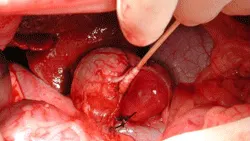Do These Dogs Have Cushing's Disease?

Case 1History. A 12-year-old neutered male miniature schnauzer presents for a routine geriatric wellness examination. The dog has had a good appetite and activity level; there are no reports of polyuria, polydipsia, or polyphagia. The owner reports that the dog has had increasingly severe "bad breath" and that the dog recently prefers canned food over his normal dry food.
Physical Examination.The dog is quiet, alert, responsive, and hydrated. Body weight is 9.2 kg, and body condition score is 4-5/9. The only abnormalities are severe halitosis, severe dental calculus, and moderate gingivitis. The dog rejects a complete oral exam and appears to be in pain.
Diagnostics. In preparation for general anesthesia and a dental prophylaxis with or without dental extractions, routine blood and urine tests are performed. Given the elevated ALP level, an ACTH stimulation test is performed. Table 1 provides all laboratory results.
CASE 1: ASK YOURSELF ...
Does this dog have Cushing's disease based on the results of the tests performed?
What is your treatment plan?
Would there have been a preferable diagnostic plan for this dog?

Case 2History. An 11-year-old spayed female Labrador retriever (Figure 1) presents for evaluation of increased water intake and inappropriate urination in the house. The dog spends most of her time indoors, and over the last few months she has started to urinate excessively in the house. Her appetite is great (she has had a ravenous appetite since she was a puppy), but her activity is somewhat decreased. The owner attributes this to older age.
Physical Examination. The dog is bright, alert, responsive, and hydrated. Body weight is 28 kg, and body condition score is 5/9. Abnormalities consist of moderate muscle atrophy, especially of the hindlimbs, a mild "pot-bellied" appearance, and thin skin.
Diagnostics. Given the history, clinical signs, physical examination findings, elevated ALP level, hypercholesterolemia, and hyposthenuria, the primary differential diagnosis is hyper-adrenocorticism. An ACTH stimulation test is performed; all test results are provided in Table 1.
CASE 2: ASK YOURSELF ...
Does this dog have Cushing's disease? If so, how do you interpret the results of the ACTH stimulation test?
What is your diagnostic and treatment plan?
Would there have been a preferable screening test for Cushing's disease in this dog?
Diagnoses
Case 1Cushing's disease should be considered only in dogs with appropriate historical and physical examination findings. This dog does not have any historical or clinical signs consistent with Cushing's disease. The elevated ALP level can be due to various isoenzymes; by itself, it is not a reason to investigate for Cushing's disease.
Improper investigation may lead to confusion, as illustrated in this example. The ACTH stimulation test may be considered consistent with Cushing's disease; however, because of the lack of appropriate historical and clinical signs, the elevated post-ACTH cortisol level is misleading.
There are 2 possible approaches for this dog:
pursue the indicated dental procedure and reevaluate the liver enzymes at a later date
pursue diagnosis of Cushing's disease or evaluation of the liver before performing the dental procedure. The decision is often based on the veterinarian's index of suspicion for Cushing's disease. In this dog, abdominal ultrasonography was performed, and the findings were unremarkable. The adrenal glands were normal in size and shape. This dog underwent a periodontal treatment along with extractions and will return for a liver panel in a month.
CASE 1: DID YOU ANSWER...
No. The ACTH stimulation test is not warranted in this scenario because there are no historical or clinical signs suggestive of Cushing's disease.
Pursue treatment of dental disease. Imaging (ie, abdominal ultrasonography) should be considered before anesthesia in this older patient, although treatment need not be delayed if the dental disease is believed to require immediate attention.
Although not recommended in this scenario, a urine cortisol:creatinine ratio or a low-dose dexamethasone suppression test would have been the preferred screening test for Cushing's disease.
Case 2In this dog, the muscle weakness and atrophy, "pot belly," thin skin, and marked polyuria and polydipsia were indicators for suspicion of Cushing's disease. Other top differential diagnoses for polyuria and polydipsia (eg, hypercalcemia, diabetes mellitus, pyelonephritis) were ruled out on the basis of blood and urine tests.
An ACTH stimulation test has lower sensitivity for Cushing's disease compared with the low-dose dexamethasone suppression test. In this case, it would be preferable to perform the latter. The results of the low-dose dexamethasone suppression test (Table 2) are consistent with Cushing's disease. However, pituitary-dependent hyperadrenocorticism and adrenal-dependent hyperadrenocorticism cannot be differentiated with these results because cortisol secretion was not suppressed.
Abdominal ultrasonography revealed a large right-sided adrenal mass with the contralateral adrenal gland at the low limits of normal size. Approximately 40% of dogs with hyperadrenocorticism caused by functioning adrenocortical tumors have ACTH stimulation test results within reference limits. Another consideration would be secretion of a different adrenal steroid (eg, 17a-OH progesterone).
This patient successfully underwent right-sided adrenalectomy (Figure 2) and histopathology revealed a cortical adenocarcinoma.
CASE 2: DID YOU ANSWER...
Yes. Cushing's disease is still the primary differential diagnosis in this patient. The ACTH-stimulation test result is false-negative because the patient has adrenal-dependent Cushing's disease. The tumor cells are autonomously releasing cortisol regardless of the ACTH result.
A low-dose dexamethasone suppression test and abdominal ultrasonography, with or without an endogenous ACTH stimulation test to verify a cortisol-secreting adrenal tumor, should be performed, followed by an adrenalectomy by an experienced surgeon at a hospital able to provide superb perioperative management. It would be reasonable to consider short-term medical treatment with trilostane for Cushing's disease to decrease the endogenous cortisol. This treatment may help reduce surgical and postsurgical complications.
A low-dose dexamethasone suppression test would have been the preferred screening test for Cushing's disease. An ACTH stimulation test can lead to false-negative results, especially if the Cushing's disease is adrenal dependent. As in the dog in this case, approximately 45% to 50% of dogs with functioning adrenocortical tumors weigh more than 20 kg.
DO THESE DOGS HAVE CUSHING'S DISEASE • Melissa Herrera & Richard W. Nelson
Suggested Reading
CVT update: Interpretation of endocrine diagnostic test results for adrenal and thyroid disease. Kemppainen RJ, Behrend EN. Kirk's Current Veterinary Therapy XIII-Philadelphia: WB Saunders, 2000, pp 321-322.Diagnosis of hyperadrenocorticism in dogs. Peterson ME. Clin Tech Small Anim Prac 22:2-11, 2007.Screening tests: Confirming a diagnosis of hyperadrenocorticism. Feldman EC, Nelson RW. Canine and Feline Endocrinology and Reproduction, 3rd ed-St. Louis: Saunders, 2004, pp 300-314.